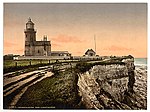Hunstanton Park Esker
Geological Conservation Review sitesSites of Special Scientific Interest in Norfolk

Hunstanton Park Esker is a 17.3-hectare (43-acre) geological Site of Special Scientific Interest east of Hunstanton in Norfolk. The esker extends 1.5 km from north of Ringstead Downs to Hunstanton Hall. It is a Geological Conservation Review site. This is a 1.5-kilometre (1-mile) esker, a long winding ridge of stratified sand and gravel dating to the glacial Devensian period, between 115,000 and 11,700 years ago. This is an uncommon landform in central and southern England. It is private land and there is no public access.
Excerpt from the Wikipedia article Hunstanton Park Esker (License: CC BY-SA 3.0, Authors, Images).Hunstanton Park Esker
King's Lynn and West Norfolk Old Hunstanton
Geographical coordinates (GPS) Address Nearby Places Show on map
Geographical coordinates (GPS)
| Latitude | Longitude |
|---|---|
| N 52.939 ° | E 0.521 ° |
Address
Ringstead Downs
PE36 5NZ King's Lynn and West Norfolk, Old Hunstanton
England, United Kingdom
Open on Google Maps









